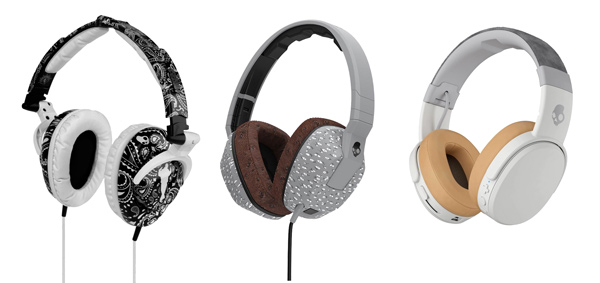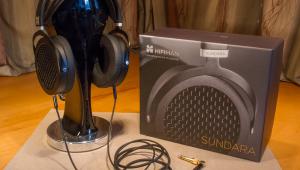| Columns Retired Columns & Blogs |
Skullcandy Crusher Wireless Over-Ear Sealed Headphones with Haptic Bass Drivers

This story originally appeared at InnerFidelity.com
For those of you who just stumbled across this InnerFidelity review as you were looking for information about the Skullcandy Crusher Wireless, welcome! InnerFidelity is a website for hard core headphone enthusiasts and it's likely you've never read headphone reviews like the ones here. I'll be going on in some detail about the technicalities of this headphone and that will probably bore you. So, I'll save you some time. I don't think the Crusher is a good sounding headphone, even for bass-heads. Let me recommend you take a look at the InnerFidelity reviews of the comparably priced Sennheiser HD 4.40 BT ($149) and the more expensive but better sounding Beats Solo3 Wireless ($299).
For the rest of you headphone geeks, I'm sure you've not been chomping at the bit for a Crusher audition, but given the haptic (vibration) transducer intended to produce the feeling of low bass response, I think it's a headphone worthy of a little satisfied curiosity. Let's have a look.
Skullcandy Crusher Wireless ($149)
The Skullcandy Crusher Wireless is actually the third in a series of Skullcandy headphones with a second driver in the headphone designed to deliver low frequency tactile information in an attempt to give you not only the sound but the feeling of sitting in a room with a subwoofer. Devices that produce information felt by touch are called haptic transducers; Skullcandy calls this feature in the Crusher "Haptic Stereo Bass" and there is a haptic driver in each earpiece.

Skullcandy's haptic bass headphones, left to right: Skullcrusher by Snoop Dogg (2010); Crusher (wired, 2014); Crusher Wireless (current).
First thing that comes to my mind seeing this new release—and all the latest Skullcandy releases—is that they've left behind all the wild color schemes. Given the firm's focus on 15-25 year old demographic and the fact they rank among the top five headphone makers in the world, I've got to think we're seeing a change in design sensibilities for the youth market.
The Crusher Wireless is certainly a subdued, and quite sensibly styled headphone that would appeal to a broad audience. It is available in both black and cream/brown color schemes. The Millennials must be maturing. Or maybe the explanation is that Skullcandy thought the kids want bling and discovered that it simply wasn't true. In either case, I do think the new headphones are markedly better looking than previous offerings.
Other than the headband arch and the adjustment sliders—that appear to be of spring or stainless steel— the headphone is an all-plastic build, which is to be expected at this price. Given the feel and look of the nicely matching bits, I would have guessed it was priced higher. This is a really nice looking headphone.
The headband's steel arch is covered with pleather on the outside and has a silicon molded headband pad over some foam on the inside. The pad is molded with some relief space in the top center to help prevent hot spots on the top of your head. There is a hinge on the headband ends to fold the cans for storage and transport. Headband ends slides in and out of the yoke tops for adjustment. The friction fit is nice a firm for a secure hold; there are no detents.
Yokes allow up and down tilt of the ear capsules, but no forward and back rotation is available. Earpads are pleather covered with a breathable panel on the inside wall; pads are removable. Opening is about average at 60mm x 40mm. Overall the fit is cozy and comfortable, above average at this price.
The 48" cable is just the right length for a portable headphone. The flat "tangle free" cable seems a bit flimsy, but that's the norm at this price. Cable is terminated with a 3.5mm TRS plug that inserts into the left earpiece. The plug body is square and does fit into a shallow hollow for some strain relief. The cable has a one-button mic/remote, and is terminated with a straight 3.5mm TRRS plug with square plastic body at the player end.
A rather short 20" USB cable is included for charging the headphones and is the only other accessory include with purchase. The USB connector is mounted directly adjacent to the 3.5mm jack on the left earpiece. The jacks are too close together to insert both cable simultaneously; the headphones do not work wirelessly when charging either. From what I can tell, the headphones are completely passive when wired---they won't turn on with the cable inserted, and I can see the impedance change when the haptic drivers are engaged. Battery life in wireless mode is claimed to be 40 hours!
The manual is very thin on the working details of the Crusher Wireless. The .pdf manual on Skullcady's site is completely unreadable; if you want a look at the manual I did find a readable copy on another site.
Controls are very simple and act as expected. The right earpiece has a "+" and "-" buttons with a circle button between on the rear of the bezel, which are easy to identify and affect with the tip of your right thumb. These buttons do double duty as volume and pause buttons when pushed once, track forward and back with long pushes, and as phone answer and volume controls during phone calls. The left earpiece has a sliding control to adjust the amplitude of the haptic low-frequency driver.
Allrightythen, let's get on to the haptic drivers and sound quality.
- Log in or register to post comments




































